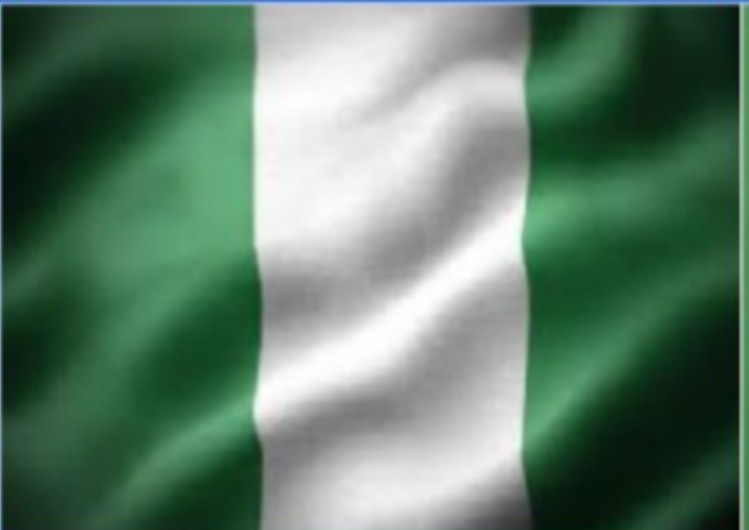Nigeria’s flag is one of the most simplified emblems of any nation on the earth, and for a sensible reason. There were reports that though the interim government chose this flag design, it was not widely endorsed by people at the onset. Nevertheless, it remained neutral and practically unchanged ever since.
(Left: The Nigerian flag. Right: Pa Taiwo Akinwunmi, the designer of the Nigerian flag)
Nigeria’s flag was also chosen to be as plain as possible, eliminating any suggestive symbols that might offend any ethnic, religious or other group. Just as in other countries with similarly broad cultural and social constitution, this was necessary in a complex and culturally diverse country as Nigeria.
Before Independence: No Common Flag or Symbol
Creating an identity through a single symbol or emblem such as a flag, did not exist amongst the indigenous people of pre-colonial Nigeria. Tribal symbols obviously could have existed. It was reported that the tribes that encountered the European traders back then, used a combination of symbols.
Indeed there was no way these diverse tribes could have agreed on any common symbol or emblem. Not especially while several inter-tribal wars raged amongst them – this was a sour period in the history of West Africa. The fallout of those wars led to the capturing of many slaves from opposing tribes.
Leaders of the tribal nation-states and empires of that time traded with the European traders by selling off captured slaves from enemy territories. The transatlantic slave trade boomed on the West African coast between the 16th and 19th Century. It was also the medium through which the British forces eventually took control of the whole region. The multiplicity of tribes and religions meant that there were no common symbols to identify the people living around the river Niger.
The Emblem of Colonial Nigeria
By merging the Northern and Southern Protectorates surrounding the river Niger, the Colony and Protectorate of Nigeria was formed by Lord Frederick Lugard. Thus Lugard became the Governor-General of the newly-formed Protectorate in 1914. And he chose a common emblem for the entire area that appeared on several colonial flags.
It was a blue ensign with the British Jack (flag) at the top left corner. Within the flag and to the right, a six-pointed star (called the ‘Seal of Solomon’) was positioned in the center of a red disk. Within that star, a royal Tudor crown and the name ‘Nigeria’ was inscribed. The tudor crown was later changed to a Saint Edward’s crown in 1953. The emblem was used from 1914 to 1959 before it was officially discarded.
The Choice of Nigeria’s Flag
In 1958, a national planning committee was set up in preparation for Nigeria’s independence. As part of the preparations, a competition to create a national flag was declared open (in 1959). About 3,000 designs (many of them with complex symbols) were reportedly submitted.
The winning design was a simple flag with three vertical stripes. It was an alternating green-white-green sequence, with a radiating red sun in the center of the white stripe. It was created by 23-year old Michael Taiwo Akinwunmi, a Nigerian student studying at Norwood Technical College in London, England. Akinwunmi had seen the advertisement for the competition in a newspaper.
In the final adopted design, the red sun in the middle of the flag was discarded. This was to eliminate all perceived bias towards any tribe, religion or group in the country. Perhaps certain symbols would be of marked significance to a particular tribe or religion. It was better to avoid the risk of honoring any group to the detriment of others (whether in an explicit or indirect way). The nationalists at that time were acutely aware of the ethnic and religious tensions that were brewing. There were definitely conflicts of cultural identity in the new Nigeria. By the way, they still exist to this day.
The two green stripes represent the natural wealth of the country – of which Agriculture was predominant. The white band represents peace and unity. The Nigerian flag was hoisted on the 1st of October 1960 (Nigeria’s Independence Day).
Some Interesting Facts about Nigeria’s Flag
The modern version of the flag often carries the Nigerian Coat of Arms, to represent the Office of the Presidency. Besides this, there are also other flags representing each of the 36 states, and each of the Armed Forces. It is a rule that no other flag is to be hoisted higher than the Nigerian national flag, as a sign of ultimate respect.
Additionally, Nigeria’s flag can only be displayed on vehicles of special dignitaries; and it must be displaced on the right fender of the car chassis (or the radiator cap). Such dignitaries include:
- The President
- The Vice-president
- Senate President
- Speaker of the House of Representatives
- State Governors
- Chief Justice of the Federation,
amongst other national dignitaries. Finally, the flag is flown at half-mast on memorial days or state funerals, as a sign of respect and national honor.
